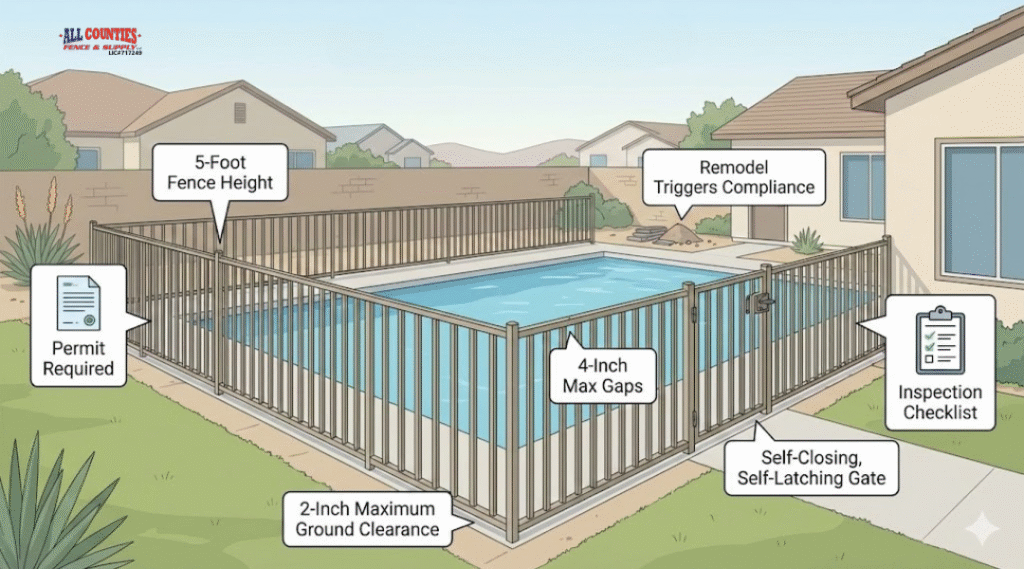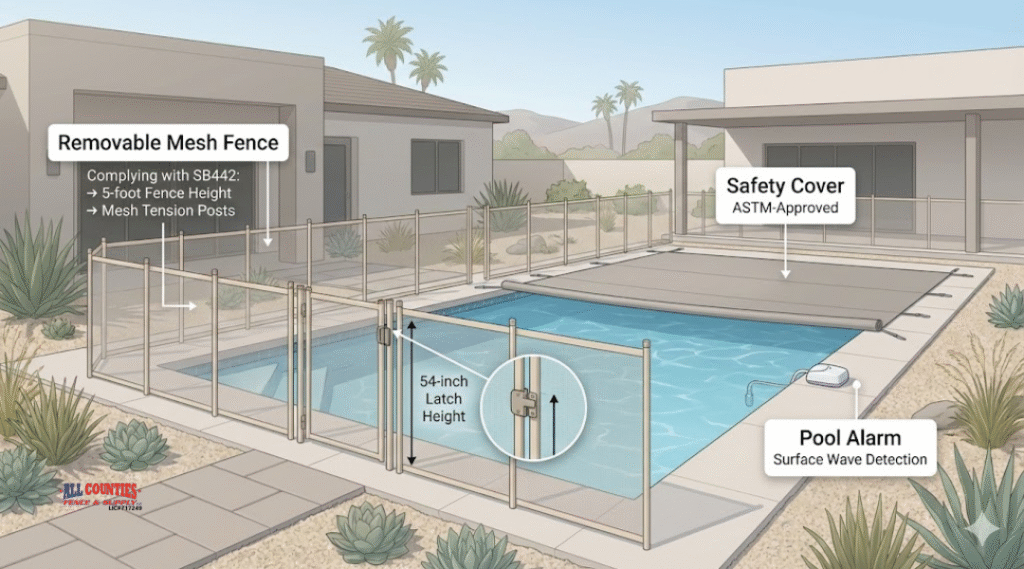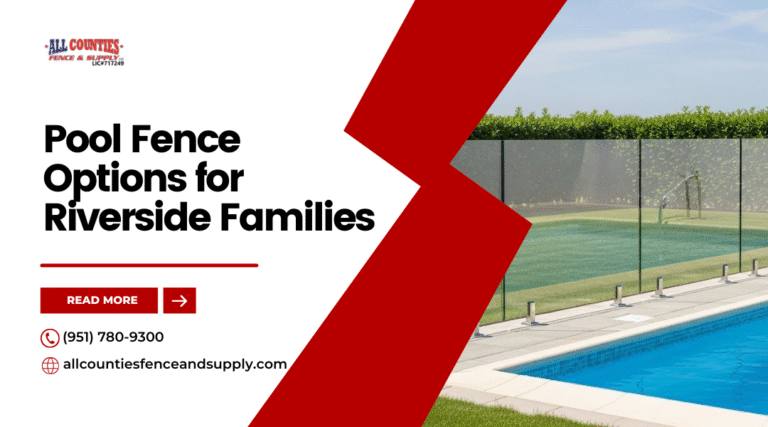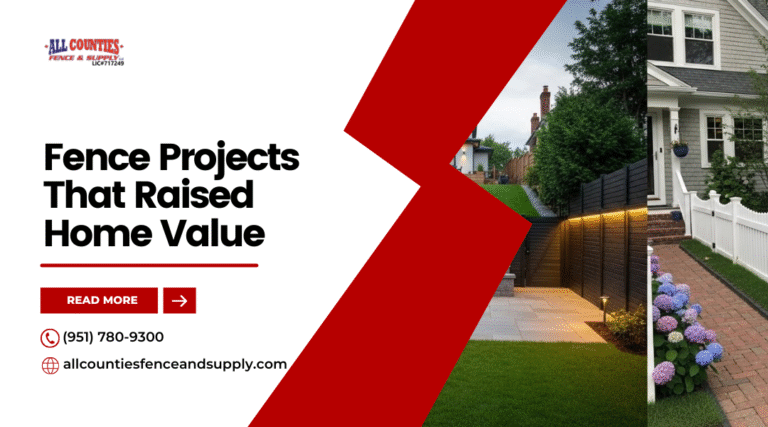Keeping your pool area safe isn’t just about peace of mind—it’s the law in California. The state’s SB442 Pool Safety Act outlines clear fence and safety barrier requirements for residential pools, and Riverside homeowners must meet those standards to avoid violations and protect their families. Under SB442, every new or remodeled pool must have a fence at least five feet tall with a self-closing, self-latching gate and two additional safety features to prevent unsupervised access.
Understanding these rules helps you make informed decisions when installing or updating your pool enclosure. From choosing compliant materials to incorporating alarms or safety covers, following SB442 ensures your pool meets both state and local regulations. This not only keeps children safer but also makes the home inspection and permitting process smoother.
Whether you’re building a new pool or verifying an existing one, learning how SB442 applies in Riverside can save time, money, and stress. Knowing the requirements before calling your fence contractor helps you stay compliant while maintaining your property’s appearance and value.
Overview of California SB442 and Pool Fence Legislation
California Senate Bill 442, also known as the Pool Safety Act, sets clear standards for how residential swimming pools must be secured to reduce child drownings. The law focuses on proper pool barriers, gate and fence specifications, and additional safety layers that protect young children from unsupervised access.
Intent of SB442 for Pool Safety
SB442 was created to strengthen the state’s existing pool safety laws and address gaps that allowed unsafe conditions around residential swimming pools. California lawmakers passed this measure to lower child drowning rates, which remain one of the leading causes of accidental injury and death among children under five.
You must have at least two independent safety features if you build or remodel a pool. This can include a 5-foot minimum fence, self-closing and self-latching gates, door alarms, or pool covers that meet safety standards. These barriers prevent direct or unintended access to pool water.
The law’s intent emphasizes prevention over enforcement. It prioritizes giving homeowners clear rules while making it easier for building inspectors to verify compliance when issuing pool permits. This approach protects your family and helps towns maintain consistent safety practices across newly built and renovated properties.
Key Legal Definitions in the Law
SB442 uses several legal terms that define how compliance is determined. Understanding these terms helps you know what the law requires and how to meet inspection standards.
Key terms include:
| Term | Meaning |
|---|---|
| Enclosure | A fence, wall, or barrier that isolates the pool from the home. |
| Separation Fence | A barrier placed between the pool and house, not around the whole property. |
| Self-Closing, Self-Latching Device | A gate mechanism that automatically shuts and locks. |
| Approved Safety Cover | A cover tested and certified to block access when the pool is not in use. |
These definitions matter when you install or upgrade a barrier system. Inspectors use them to decide whether a feature qualifies under California pool fence regulations. A gate that swings away from the pool and latches automatically typically satisfies the standard, while an upward-opening latch placed at least 54 inches high keeps it out of reach of small children.
Applicability to Residential Pools
The law applies to all new and remodeled residential swimming pools and spas that require building permits. It also affects existing pools if you make significant repairs or add structures that require reinspection. When you buy or sell a home, inspection reports must list which safety measures are in place and if the pool meets the 5-foot fence requirement.

You must comply with SB442 even if your property already has a perimeter fence. If your fence is lower than 5 feet or has openings larger than 4 inches, you’ll need to modify it or add approved safety layers, such as door alarms or a removable mesh fence. The bottom of the fence cannot be more than 2 inches above the ground.
Homes in Riverside and other California counties must follow local building codes that align with state pool safety standards. This ensures uniform protection across communities and helps local authorities verify that homeowners meet California pool fence laws before approving occupancy or closing property sales.
Fundamental Pool Fence Requirements Under SB442
California’s SB442 sets clear standards for residential pool enclosures to reduce the risk of accidental drownings. You must meet specific rules for the height, materials, gate operation, and spacing of your pool fence so it serves as a reliable physical barrier.
Minimum Height and Barrier Design
Your pool fence must stand at least 5 feet tall, measured from the exterior side facing away from the pool. This height creates a secure boundary, making it difficult for young children to climb over. The space between the bottom of the fence and the ground cannot exceed 2 inches, and any openings or gaps must be less than 4 inches wide.
The design should not include footholds, horizontal rails, or decorative features that make climbing easier. The outside surface must be smooth and free of protrusions or cavities. If your property fence serves as the pool barrier, it must meet these same dimensional rules.
When remodeling or selling a home, inspectors check that these standards are met. If your existing fence does not comply, you may need to add a secondary safety layer, such as a removable mesh pool fence or other protective device.
Permitted Fence Materials and Features
SB442 allows several material options, but they must create a continuous and durable barrier. You can use wood, metal, glass, or mesh as long as the fence cannot be easily climbed or broken. Mesh fences must meet ASTM F2286 pool safety standards and remain at least 20 inches away from the pool’s edge.
For metal or wrought iron fences, vertical pickets should be spaced close enough to prevent a 4-inch sphere from passing through. Wood fences should have solid panels or vertical slats with no horizontal crossbars near the middle. Chain-link fencing is discouraged unless it has small openings or a vinyl mesh backing.
Adding additional protection is often required. Options include alarms on doors leading to the pool area, safety covers, or self-closing gates. Using approved materials ensures your fence meets both state law and local building codes enforced in Riverside.
Gate Placement and Self-Latching Requirements
Your pool gate must swing outward, away from the water. This direction prevents a child from pushing the gate open while moving toward the pool. It also must self-close and self-latch after each use. The latch’s release must sit at least 54 inches above ground level, keeping it out of reach of small children.
If you install more than one gate, each needs its own self-closing and self-latching mechanism. Gates cannot have large gaps at the sides or bottom that would allow a child to crawl through. Avoid placing furniture, planters, or decorative items near the gate that could provide climbing access.
When you have automatic driveway gates that open into a pool area, they must fully close within 20 seconds. These small technical features are key parts of compliance and directly affect how inspectors assess your pool safety under SB442.
Additional Approved Safety Measures
California’s Swimming Pool Safety Act (SB 442) allows homeowners to choose from several approved safety measures that go beyond fencing. These safeguards reduce drowning risk and help ensure your property meets state and local safety requirements. Devices such as removable mesh fencing, approved safety pool covers, and pool alarms each add a unique layer of protection.

Removable Mesh Fencing Compliance
Removable mesh fencing offers flexibility while maintaining compliance with California’s pool safety standards. To meet ASTM F2286 requirements, the material must be strong enough to resist climbing and equipped with a self-closing, self-latching gate. The gate latch should sit at least 54 inches above the ground to stay out of reach of small children.
You can remove the fencing when the pool is not in use, but reinstalling it before swimming is essential for continued safety compliance. Mesh panels must be tensioned and anchored securely to prevent sagging or gaps. Local inspectors in Riverside may verify that your installation meets the height and locking-device standards listed in Section 115923 of the California Health and Safety Code.
When maintained properly, removable fencing provides an effective, low-visibility barrier that protects without permanently altering your yard’s layout.
Role of Approved Safety Pool Covers
An approved safety pool cover provides a mechanical barrier across the pool surface. To comply with California’s Section 115921(d), the cover must support a specific minimum weight, prevent accidental entry, and pass testing for load-bearing integrity and drainage.
Unlike decorative or solar covers, safety-rated models use reinforced materials and safety latches that lock into place. Automated covers can improve convenience, but manual versions also qualify if they meet the state’s durability and strength requirements.
Before purchase, look for certification labels or documentation confirming compliance with ASTM standards. You should also inspect the system regularly for wear around track edges and fastenings. A properly installed cover not only prevents accidental falls but also helps reduce debris, evaporation, and heating costs.
Pool Alarms and Electronic Safety Options
Pool alarms detect motion or pressure changes in water and sound an alert when someone or something enters the pool unexpectedly. Under SB 442, any alarm used for safety compliance must meet ASTM F2208 specifications, which verify adequate sensitivity and resistance to false triggers.
You can choose among surface motion, subsurface pressure, or infrared beam alarms. Door or gate alarms also enhance perimeter security by signaling when access points open. The release control for each alarm should remain reachable for adults but inaccessible to children.
Regularly test alarm batteries and sensors to confirm reliability. Combining electronic devices with physical barriers like fencing and covers creates layered protection that significantly reduces drowning risks on your property.
Preventing Accidental Drowning and Pool Safety Rationale
California’s pool safety regulations aim to reduce child drownings by requiring physical barriers, safety features, and clear homeowner responsibilities. These standards help ensure that every pool area in Riverside meets state and local laws while providing effective protection against unsupervised access.
Importance of Barriers in Reducing Drowning Risks
Physical barriers such as fences, gates, and covers are the most reliable way to prevent accidental drowning. A fence at least 5 feet high with a self-closing, self-latching gate creates a secure boundary that limits a child’s ability to reach the water. This layered approach aligns with California SB442 and has been proven effective in reducing drowning incidents among children under five.
You must also ensure openings in the fence are no more than 4 inches wide and that the bottom of the fence is no more than 2 inches from the ground. These specifications keep small children from squeezing through or crawling under.
By maintaining a solid, climb-resistant barrier, you comply with statewide pool safety standards while lowering your risk of tragedy, liability, or fines. Barriers protect lives by delaying access long enough for an adult to intervene.
Supportive Data on Pool Safety and Drowning Prevention
Data from the Centers for Disease Control and Prevention (CDC) shows drowning is one of the top causes of unintentional death for children ages 1–4. In California, most drownings occur in home pools where no protective barriers or alarms are installed.
Studies indicate that proper fencing can cut the risk of child drowning by up to 80%. The state’s Pool Safety Act (SB442) requires two or more safety features, such as alarms, covers, or mesh fencing, based on this evidence.
| Safety Feature | Required Standard | Primary Function |
|---|---|---|
| Pool fence | 5 ft minimum height | Blocks unsupervised entry |
| Gate latch | ≥54 in above ground | Keeps latch out of children’s reach |
| Exit alarms | 85 dB minimum | Alerts you to unauthorized access |
Consistent enforcement of these standards across counties like Riverside strengthens protection statewide and supports measurable reductions in drowning deaths.
Homeowner Responsibility
As a homeowner, you play the leading role in maintaining pool safety compliance. State law holds you accountable for keeping all protective features operational and up to code. A non-working gate latch or disabled alarm can create serious hazards and potential legal penalties.
You should routinely check your fence, gate, and safety devices for wear or malfunction. When remodeling or building a pool, ensure your contractor follows local building codes and installs approved safety systems.
In addition to equipment, active supervision is essential. Barriers reduce risk but do not replace watchfulness. Combining observation with a compliant pool safety system ensures your pool area remains secure and consistent with Riverside’s enforcement of SB442 pool safety regulations.
Installation and Maintenance Guidelines for Riverside Homeowners
Follow clear rules when building and caring for your pool fence to keep it safe and compliant. Focus on proper installation methods, consistent maintenance, and routine inspections to meet California SB442 and Riverside County standards.
Best Practices for Professional Fence Installation
Hire a licensed contractor familiar with California SB442 and local Riverside County ordinances. You need a fence at least 5 feet tall, measured from the outside of the pool area. The gap under the fence should be less than 2 inches, with vertical openings under 4 inches to prevent small children from squeezing through.
All gates must be self-closing and self-latching, with latches mounted at least 54 inches above the ground. Avoid horizontal bars or decorative features that can serve as footholds.
Keep the fence at least 20 inches from the pool edge to allow space for patrol and cleaning. Before installation, review your site plan with the building department to confirm that the layout and materials meet current California Building Code (T-24) standards.
Essential Tips for Pool Fence Maintenance
Inspect your fence monthly for loose posts, rust, or signs of wear. Even small damage can lower its strength and make it unsafe. Tighten or replace weak fasteners and check that gates close and latch automatically every time.
Use mild soap and water to wash mesh, vinyl, or metal surfaces to prevent buildup of dirt and chlorine residue. If your fence is mesh, make sure panels stay taut and free from tearing. Replace broken latch springs or warped gate parts right away.
Keep shrubs, outdoor furniture, and pool equipment away from the fence to avoid creating climbable points. Record maintenance in a simple log like:
| Date | Task | Notes |
|---|---|---|
| 5/15/25 | Checked gate latch | Working properly |
| 6/10/25 | Cleaned fence surface | No corrosion found |
Inspection Requirements and Ongoing Compliance
Riverside County requires fences to meet state and local pool safety codes before final approval of a pool permit. After installation, you may receive unannounced inspections from environmental health specialists who verify compliance with height, gate, and latch standards.
If you remodel or sell your home, your pool fence must still meet current SB442 requirements. Home inspectors often note deficiencies in reports, and buyers can request updates before closing.
To stay compliant, review code updates annually and fix any issues promptly. Keep records of professional inspections and receipts for repairs. Regular attention protects your family’s safety and helps avoid costly code violations.
Local Riverside and California Compliance Considerations
You must follow both California pool fence laws and local Riverside County ordinances to keep your property compliant. Meeting these rules protects your family’s safety and helps you avoid costly violations.
Differences in Riverside County Ordinances
Riverside County adopts the California Residential Code and SB442, which set statewide safety standards for residential pools. However, the county also enforces unique fence design and height rules that may differ slightly from neighboring areas.
Your pool barrier must be at least 5 feet high, measured from the outside of the fence. The clearance at the bottom cannot exceed 2 inches from the ground, or 4 inches if installed over concrete. Openings in the fence should not allow a sphere larger than 1¾ inches to pass through.
Gates must open away from the pool, close automatically, and include self-latching mechanisms. If your home acts as part of the barrier, each exterior door to the pool area must have a self-closing latch or door alarm of at least 85 decibels. Always confirm the latest requirements with the Riverside County Department of Building and Safety, since ordinances may change.
Permitting Process and Approval Steps
Before building or altering your pool fence, you need a permit from Riverside County’s Building and Safety Department. Plan submittals must include:
- A site plan showing property lines, the pool layout, and the fence location.
- Construction details that match the county and California pool fence regulations.
- A list of materials and specifications for gates and latches.
The county will review your design for consistency with the California Building Code and local amendments. Once approved, you may schedule installation. Inspections occur before and after construction to verify fence height, gate operation, and safety features.
Getting approval early helps you avoid costly corrections later. If you use a licensed contractor, ensure they submit documentation promptly to prevent delays.
Penalties for Non-Compliance
Failure to meet pool barrier standards can result in fines, stop-work orders, or denied occupancy permits. Inspectors may require you to remove or rebuild non-compliant fences before authorizing pool use.
For serious violations, the county can cite property owners and issue daily fines until the hazard is corrected. Insurance carriers may also refuse coverage for accidents linked to unapproved or unsafe barriers.
You protect your property and liability status by keeping your pool enclosure in full compliance with both California pool fence laws and Riverside County ordinances. Always correct issues immediately after inspection notices to avoid escalating penalties.




